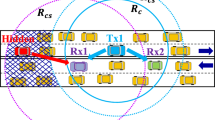Abstract
In vehicular networks, radio waves propagate in an external environment and are therefore subject to many obstacles such as buildings, trees or hills. Modeling the transmission range by a perfect circle around each transmitter is absolutely wrong especially in urban environments. In our previous work, we defined a terrain characteristics-based propagation model for vehicular network. This model determines the received signal power according to the type and the density of obstacles encountered by the radio waves. In this paper we calibrate the model parameters to meet the physical layer specifications of the standard dedicated to inter-vehicular communication, 802.11p. We validate the new values by several simulation tests. Based on this model, we present a study of the radio connectivity for a vehicular network in city environment and evaluate the impact of obstacles on information dissemination in such a network. The tests are performed by considering a simulation environment that represents a real city map. We define several metrics characterizing the radio connectivity and the information dissemination and examine the effect of vehicles density and obstacles on those metrics.
Similar content being viewed by others
References
IEEE P802.11p/D2.01 (2007). Standard for wireless local area networks providing wireless communications while in vehicular environment, Mar. 2007.
Camp, T., Boleng, J., & Davies, V. (2002). A survey of mobility models for ad hoc network research. Wireless Communications and Mobile Computing (WCMC), 2(5), 483–502. Special issue on Mobile Ad Hoc Networking: Research, Trends and Applications.
Härri, J., Filali, F., & Bonnet, C. (2007). Mobility models for vehicular ad hoc networks: a survey and taxonomy (Technical Report RR-06-168). Institut Eurecom, January 2007.
Molisch, A., Turfvesson, F., Karedal, J., & Mecklenbrauker, C. (2009). Propagation aspects of vehicle-to-vehicle communications—an overview. In IEEE radio & wireless symposium, January 2009.
Martinez, F. J., Toh, C. K., Cano, J. C., Calafate, C. T., & Manzoni, P. (2009). Realistic radio propagation models (RPMs) for VANET simulations. In IEEE wireless communications & networking conference (WCNC 2009), Budapest, Hungary, April 2009.
Nagel, R., & Eichler, S. (2008). Efficient and realistic mobility and channel modeling for VANET scenarios using OMNeT++ and INET-framework. In Proc. of the 1st international conference on simulation tools and techniques for communications, networks and systems & workshops, Marseille, France, March 2008.
Sun, Q., Tan, S. Y., & Teh, K. C. (2005). Analytical formulae for path loss prediction in urban street grid microcellular environments. IEEE Transactions on Vehicular Technology, 54, 4.
Giordano, E., Frank, R., Pau, G., & Gerla, M. (2010). CORNER: a realistic urban propagation model for VANET. In The seventh international conference on wireless on-demand network systems and services (WONS), Kranjska Gora, Slovenia, February 2010.
Wang, S. Y. (2005). The effects of wireless transmission range on path lifetime in vehicle-formed mobile ad hoc networks on highways. In Proc. IEEE international conference on communication (ICC), May 2005 (pp. 3177–3181).
Artimy, M. M., Robertson, W., & Phillips, W. J. (2004). Connectivity in inter-vehicle ad hoc networks. In Proc. IEEE Canadian conference on electrical and computer engineering (CCECE) Canada, May 2004 (pp. 293–298).
Conceição, H., Ferreira, M., & Barros, J. (2008). On the urban connectivity of vehicular sensor networks. In Proc. 4th IEEE international conference on distributed computing in sensor systems (DCOSS’08), Greece, June 2008 (pp. 112–125).
Fiore, M., & Härri, J. (2008). The networking shape of vehicular mobility. In Proc. of ACM MobiHoc, China, May 2008 (pp. 261–272).
Ait Ali, K., Baala, O., Caminada, A., & Lalam, M. (2010). Evaluating vehicular radio connectivity with environment-based metrics. In Third joint IFIP wireless and mobile networking conference (WMNC’10), Budapest, Hungary, October 2010.
Erceg, V., Greenstein, L. J., et al. (1999). An empirically based path loss model for wireless channels in suburban environments. IEEE Journal on Selected Areas of Communications, 17, 1205–1211.
Ait Ali, K., Lalam, M., Moalic, L., & Baala, O. (2010). V-MBMM: vehicular mask-based mobility model. In Proc. of the 9th international conference on networks ICN 2010, French Alps, France, April 2010.
Joumaa, C., Caminada, A., & Lamrous, S. (2007). Mask based mobility model: a new mobility model with smooth trajectories. In SpaSWiN 2007, Limassol, Cyprus, April 2007.
Joumaa, C., Caminada, A., & Lamrous, S. (2007). Mask based mobility model: a 2-D indoor 3-D outdoor mobility model. In EMC Europe workshop, Paris, France, June 2007.
Trieber, M., Hennecke, A., & Helbing, D. (2000). Congested traffic states in empirical observations and microscopic simulations. Physical Review E, 62(2), 1805–1824.
The ns-2 Network Simulator. http://www.isi.edu/nsnam/ns/, December 2010.
Author information
Authors and Affiliations
Corresponding author
Rights and permissions
About this article
Cite this article
Ait Ali, K., Baala, O. & Caminada, A. Revisiting vehicular network connectivity with radio propagation model. Telecommun Syst 52, 2585–2597 (2013). https://doi.org/10.1007/s11235-011-9591-4
Published:
Issue Date:
DOI: https://doi.org/10.1007/s11235-011-9591-4




